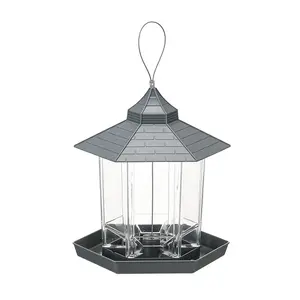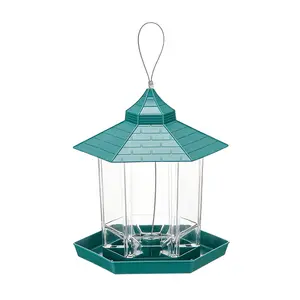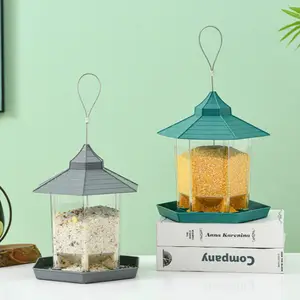
All categories
Featured selections
Trade Assurance
Buyer Central
Help Center
Get the app
Become a supplier

(924 products available)




















































Small hummingbird feeders come in various designs to cater to the diverse needs of hummingbirds and their keepers. The primary difference between these types is how the food is dispensed, how many birds they attract, and even some differences in the design aesthetics.
Some of these options include window-mounted feeders, which are small, sophisticated glass and metal feeders that attract many hummingbirds. These feeders are simply vacuum-mounted on windowpanes and allow for food to be served without real estate concerns, drawing birds just a few inches away in perfect view. This size is also not appreciably larger than a bird feeder for small yards, making it easy to use in a variety living situations.
Orchard hummingbird feeders attract these birds by providing a place for them to feed id wires within the feeder. These feeders usually have small feeding ports with perches located close to them. This design allows the hummingbirds to get to the nectar pots with minimal effort. As a result, these kinds of feeders typically attract orchard hummingbirds that mainly prefer fruits and serve as an extra food source.
Continuous supply hummingbird feeders are another type that draws hummingbirds to blooming plants while providing extra nectar. These feeders have a flower-shaped feeding port and are usually placed in proximity to flowering plants. This design mimics the bird’s natural feeding habits and provides a constant source of nectar to the birds; thus, the name continuous supply feeder.
The last type is a hummingbird bath feeder that provides birds with water for thirst and bathing, in addition to nectar. These feeders are especially useful in dry seasons or in areas where natural water sources are scarce. It is important to add a hummingbird bath feeder so that hummingbirds would have an adequate supply of water in addition to their food.
Small hummingbird feeders are designed mainly for convenience, durability, and aesthetic purposes while ensuring easy access for the birds.
Apart from this, some feeders have window-mounts for the glass feeders, which include nectar reservoirs, feeding ports, and often perches. These feeders are exceptionally compact, usually no larger than a few inches across. They attach to windows using vacuum suction cups, providing a direct view of the birds that are close to feeding. They are unobtrusive and allow the users to see the birds without taking up space in the yards.
Disk-type feeders, on the hand, have simple and efficient designs that consist of flat platforms with feeding ports or flower-shaped reservoirs. These feeders should be placed in areas that are quite open, as the design allows for quick and easy feeding without much effort on the part of the birds. Many of these feeders also resemble flowers as this attracts the birds more and encourages them to visit the feeder.
Feeder bottles have a very compact design, featuring a small nectar reservoir and a feeding port. The bottle design is leak-proof and helps save space. The small size makes it suitable for gardens or balconies with limited space. While the bottle shape is mainly for function, some have decorative elements that are easy to fit into the environment.
Automatic hummingbird feeders also have a very basic design. What distinguishes them from others is that they feature a mechanism for automatically releasing nectar based on the birds' feeding habits. This type of feeder usually has a simple and compact design. While it is not too complicated to fill, the feeder is equipped with a smart mechanism for feeding the birds. Many of these feeders are equipped with fresh nectar dispensers to keep the nectar always fresh for the birds.
Proper maintenance is essential for small hummingbird feeders to ensure that the birds have access to clean and safe nectar at all times. It is also important to prevent the feeder from becoming clogged or damaged after prolonged use.
The specification for these feeders mainly depends on their size, materials, and types of nectar ports and feeding areas. Ant moats are extra add-ons that are placed above the feeding ports on hummingbird feeders to trap and kill ants. Thrushes like the moats will ignore the nectar and try to eat the insects instead. Besides, the moat is a very small water feature on the feeder that creates a barrier between ants and the nectar. Hummingbird feeders may also have built-in ant moats that prevent ants from getting into the nectar.
Some feeders come with insect guards, which are small screens or mesh positioned at the base of the feeder or around the feeding port. These guards are designed to keep non-target insects like wasps and bees from accessing the nectar. Insects like wasps and bees have difficulty squeezing through the small openings in the mesh, while hummingbirds can easily pass through and access the nectar.
All parts of the feeder should be easily removable for cleaning. Many feeders are designed with wide openings and simple, snap-together, or screw-on components that can easily be disassembled. Look for feeders with smooth surfaces and fewer decorative elements that can harbor mold. Avoid feeders with complex designs that are difficult to clean.
Nectar in the feeders, especially homemade kinds, should be changed at least once every few days. This prevents the nectar spoilage, which can cause diseases to the birds. Clean the feeder with warm soapy water and a brush to remove all nectar residues and mold. Rinse thoroughly to wash away soap residue. Do not use bleach or strong chemicals that can harm the birds. Consider using a vinegar solution to clean the feeder. This helps get rid of stubborn mold and bacteria.
Make sure to clean the feeder before refilling it with nectar. This ensures that the birds are receiving fresh and clean nectar all the time. Inspect the feeder regularly for signs of mold, leaks, or damage. Replace any parts damaged by weather elements, and do not hesitate to get a new feeder, especially if the mold cannot be removed. Regularly check and clean the ant moats and insect guards if the feeder is equipped with these features to ensure they are functioning properly.
Bird watchers and nature lovers may consider small hummingbird feeders as a great addition to attract these amazing birds to their space. Hummingbird feeders can be placed almost anywhere for personal enjoyment or to enhance a business environment.
For homeowners, added a small hummingbird feeder in the garden allows them to enjoy the beauty of these birds from the comfort of their homes. It also provides food for the birds and acts as a natural source of attraction. Keep the feeders filled with sugar water during the migration to make the birds stop over for a snack. Placing multiple feeders in different areas of the yard will help attract more hummingbirds and allow them to perform aerial displays while giving the guests an amazing view.
For apartment dwellers who don't have a lot of outdoor space, window feeders make it possible to watch the hummingbirds up close. This is great for people living in urban areas or anyone with limited yard space. The birds will attach the window-mounted feeders as they see them and enjoy watching them. Simple hummingbird feeders can also be added to patios or balconies for more beauty on the space.
Farmers and agricultural workers can use a small hummingbird feeder to pollinate crops and flowering plants. This benefits both the birds and the keepers, as it attracts the birds while helping the plants or crops grow. When hummingbirds flock to the feeders, they also help pollinate nearby flowers, which boosts the plants' production and health. In such a scenario, hanging feeders nearby creates a continuous supply of nectar to the hummingbirds and encourages them to visit the flowers.
Small hummingbird feeders can also be used in schools, parks, and nature centers to teach people about the importance of wildlife conservation. They offer an opportunity for people to connect with nature and learn more about the birds. Kids will especially love seeing hummingbirds feeding on the flowers through the feeders. It encourages them to learn more about these birds and their habitat.
Small hummingbird feeders are a great option for keeping the birds close by while also giving people the best view of them. They come in various designs and can be conveniently placed on a window, allowing users to enjoy the beauty and grace of these tiny birds up close. This makes them ideal for people living in urban areas, apartment dwellers, or anyone with limited outdoor space.
A1: Hummingbirds eat a sugar-water mixture, which is the most popular food source for hummingbirds. This is because most feeders are designed to hold sugar, water, and nectar, which are the foods these birds love. This mixture closely resembles the nectar flowers give off.
A2: No, small hummingbird feeders are not for pets. They provide hummingbirds with food and water only. These feeders are designed only for birds and are wall-mounted, bowl, and bottle feeders that are meant for small birds like hummingbirds.
A3: The nectar in a hummingbird feeder should be changed at least once every few days. This will prevent nectar spoilage, which can cause diseases to the birds. Clean the feeder with warm soapy water and a brush to remove all nectar residues and mold.
A4: Cleaning a hummingbird feeder is simple and straightforward. Rinse the feeder thoroughly with water. Use a brush to scrub the interior surfaces. Fill the feeder with a mixture of water and white vinegar and let it soak for several hours. Rinse again with water to remove all vinegar residues.
A5: Yes, some hummingbird feeders have nectar reservoirs with feeding ports that are open to ants. A lot of hummingbird feeders don't have any protection against ants. Ants have a very strong sense of smell, and they will do anything just to get to the nectar to eat.